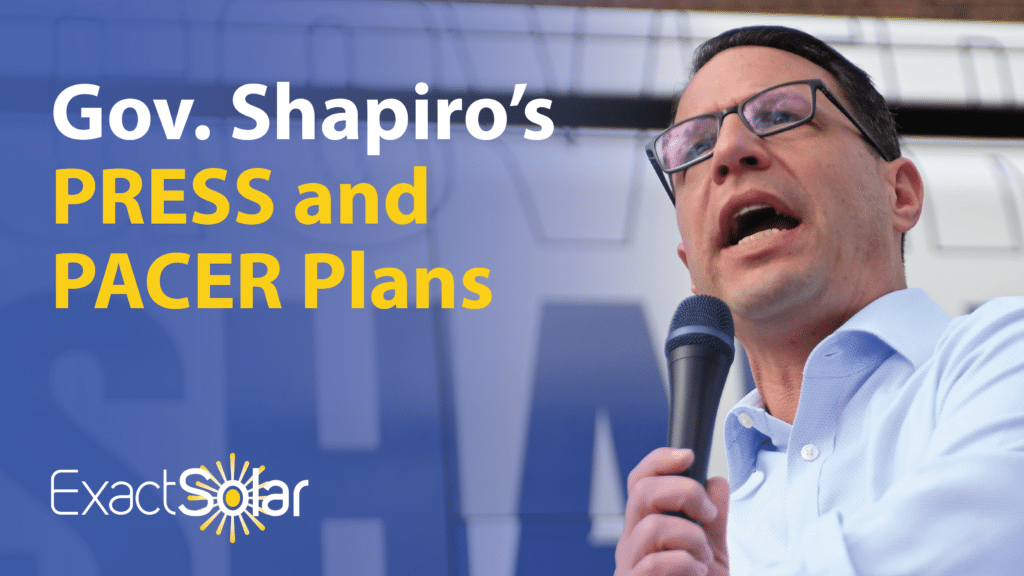
On March 13, 2024, Governor Shapiro unveiled his plans to bring Pennsylvania into the future of energy while maintaining our status as an energy leader. If you’re wondering how you can help, we’ve included a call to action at the bottom of today’s article.
From his official press release:
“Pennsylvania is still falling behind other states in the race to diversify its energy sources and create clean, reliable, and affordable energy. The Governor’s energy plan will help to cement Pennsylvania’s place as one of the world’s top energy producers and insulate consumers from rising utility costs as a result of global instability and foreign wars.”
The Governor’s plans, PACER (Pennsylvania Climate Emissions Reduction Act) and PRESS (Pennsylvania Reliable Energy Sustainability Standard) aim to significantly reduce carbon emissions and increase renewable energy sources in PA. These initiatives would dramatically increase Pennsylvania’s commitment to combating climate change and foster economic growth by creating green jobs and stimulating investment in clean energy technologies.
At Exact Solar, we’ve been hard at work behind the scenes, building support for legislators fighting to update the AEPS. Pennsylvania’s renewable energy targets need to change. Whether we get there through PRESS, PACER, or by passing House Bill 1467 or Senate Bill 230 remains to be seen.
The Governor’s office estimates that the PACER and PRESS proposals will save ratepayers $250 million over five years and create 14,500 jobs, signaling a robust market for renewable energy projects and services. Already, environmental and renewable energy groups are praising Shapiro’s proposed shift towards cleaner energy, and traditional energy and fossil fuel groups are pushing back.
Exact Solar supports the state’s proposed clean energy objectives and Pennsylvania’s transition to a more sustainable and economically vibrant energy future.
PACER and PRESS Top Changes
Below, we’ve compiled a quick guide to the changes PACER and PRESS legislation would bring, outlining the potential impacts and benefits for the state’s energy landscape.
PACER (Pennsylvania Climate Emissions Reduction Act)
- Establishes a State-Specific Cap-and-Invest Program: PACER aims to cap carbon emissions within Pennsylvania, allowing the state to set its own emission limits and carbon credit prices.
- Introduces Electric Bill Rebates: Approximately 70% of the revenue generated from selling carbon credits will be returned to residents as rebates.
- Supports Low-Income Households: A portion of the remaining funds from selling carbon credits will be used to further reduce energy bills for low-income Pennsylvanians.
- Invests in Clean Energy: PACER mandates that Investments be made in clean energy and energy efficiency projects for homes and small businesses.
- Creates Carbon Capture and Storage Funds: Some funds will be invested in carbon capture and storage technology, including retrofitting natural gas plants.
- Initiates Withdrawal from RGGI: Pennsylvania would withdraw from the Regional Greenhouse Gas Initiative (RGGI) and create/manage its own carbon pricing scheme.
- Creates Energy Jobs: PACER creates energy jobs within the state of Pennsylvania as part of the energy transition.
- Begins Pollution Reduction: Measures will be taken to reduce pollution throughout Pennsylvania.
- Boosts Economic Growth and Energy Transition: PACER aims to stimulate economic growth while transitioning part of Pennsylvania’s portfolio to cleaner energy sources.
- Gives Energy Policy Control to PA: Pennsylvania will have greater control over its energy policy, independent of other states’ mandates and decisions.
PRESS (Pennsylvania Reliable Energy Sustainability Standard)
- Increases Clean Energy Goals: PRESS sets a goal for Pennsylvania to achieve 35% of its energy from clean sources by 2035.
- Restructures Energy Tiers: The proposal reorganizes energy sources into three tiers, focusing on promoting cleaner energy sources in Tier I.
- Expands Tier I Energy Sources: Tier I would includes solar, wind, low-impact hydropower, geothermal, and nuclear technologies as.
- Introduces New Energy Tiers: Tier II will include larger hydropower, certain forms of natural gas, and biomass, while Tier III will focus on waste coal and other less clean sources.
- Targets for Diverse Energy Sources: Aims for a more diverse and reliable energy mix, including 10% from sustainable sources and 5% from ultra-low emission traditional fuels by 2035.
- Economic Investment and Job Creation: Expected to attract federal investments and create jobs, contributing to economic growth.
- Enhances Energy Grid Reliability: Designed to improve the reliability and affordability of the energy grid.
- Excludes Cryptocurrency Mining: Electricity used for cryptocurrency mining will not be eligible for PRESS credits.
- Promotes Advanced Technologies: Encourages developing and using advanced energy technologies, such as small modular reactors and nuclear fusion.
- Long-term Energy Strategy: Aims for a sustainable and diversified energy future for Pennsylvania.
So, What Can You Do?
A few months ago, we published How Pennsylvania Homeowners Can Help Raise SREC Prices, and asked that you set up a face-to-face meeting with your state representative and say that you support updating the AEPS.
We’re still fighting the same battle, which is why Governor Shapiro has introduced PRESS and PACER.
HB 1467 and SB 230 have not passed, and the Pennsylvania legislature is still engaged in a bitter battle over RGGI.
If you want to support the fight for better renewable energy standards in Pennsylvania, find your state representative with Legis, and call to set up a face-to-face meeting via Zoom (emails just get lost and buried). Tell them:
“We want an update to the AEPS, whether that’s through passing HB 1467, SB 230, or passing Governor Shapiro’s PRESS or PACER initiatives. We want a fair price for Pennsylvania SRECs and the best way to get there is by requiring more renewable energy in Pennsylvania’s portfolio.”
